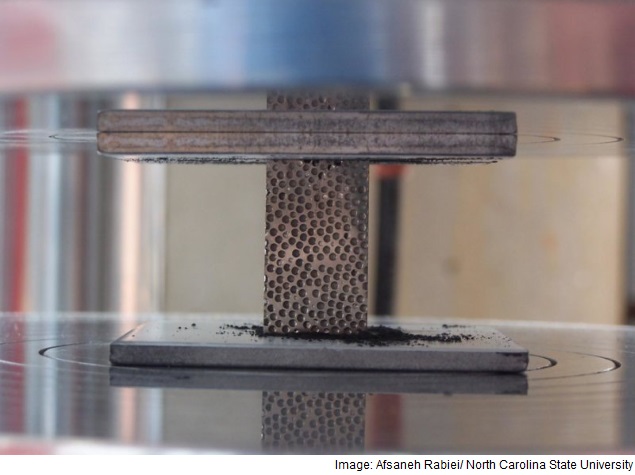- Home
- Science
- Science News
- Metal Foams Capable of Shielding Radiation Developed
Metal Foams Capable of Shielding Radiation Developed

The metal foams hold promise for use in nuclear safety, space exploration and medical technology applications.
"This work means there's an opportunity to use composite metal foam to develop safer systems for transporting nuclear waste, more efficient designs for spacecraft and nuclear structures, and new shielding for use in CT scanners," said Afsaneh Rabiei, professor of mechanical and aerospace engineering at North Carolina State University.
Rabiei first developed the strong, lightweight metal foam for use in transportation and military applications. But she wanted to know if the foam could be used for nuclear or space exploration applications.
For this, she and her colleagues conducted multiple tests to see how effective it was at blocking X-rays, gamma rays and neutron radiation.
The most effective composite metal foam against all three forms of radiation is called "high-Z steel-steel" and was made up largely of stainless steel, but incorporated a small amount of tungsten.
The foam also outperformed other materials at blocking neutron radiation.
"However, we are working to modify the composition of the metal foam to be even more effective than lead at blocking X-rays - and our early results are promising," said Rabiei in a study outlined in the journal Radiation Physics and Chemistry.
"The extraordinary mechanical and thermal properties of composite metal foams, and their energy absorption capabilities, make the material a good candidate for various nuclear structural applications," Rabiei added.
Get your daily dose of tech news, reviews, and insights, in under 80 characters on Gadgets 360 Turbo. Connect with fellow tech lovers on our Forum. Follow us on X, Facebook, WhatsApp, Threads and Google News for instant updates. Catch all the action on our YouTube channel.
Related Stories
- Samsung Galaxy Unpacked 2025
- ChatGPT
- Redmi Note 14 Pro+
- iPhone 16
- Apple Vision Pro
- Oneplus 12
- OnePlus Nord CE 3 Lite 5G
- iPhone 13
- Xiaomi 14 Pro
- Oppo Find N3
- Tecno Spark Go (2023)
- Realme V30
- Best Phones Under 25000
- Samsung Galaxy S24 Series
- Cryptocurrency
- iQoo 12
- Samsung Galaxy S24 Ultra
- Giottus
- Samsung Galaxy Z Flip 5
- Apple 'Scary Fast'
- Housefull 5
- GoPro Hero 12 Black Review
- Invincible Season 2
- JioGlass
- HD Ready TV
- Laptop Under 50000
- Smartwatch Under 10000
- Latest Mobile Phones
- Compare Phones
- OnePlus 15R
- Realme Narzo 90x 5G
- Realme Narzo 90 5G
- Vivo S50 Pro Mini
- Vivo S50
- OPPO Reno 15c
- Redmi Note 15 5G
- Redmi Note 15 Pro 5G
- Asus ProArt P16
- MacBook Pro 14-inch (M5, 2025)
- Infinix Xpad Edge
- OnePlus Pad Go 2
- OnePlus Watch Lite
- Just Corseca Skywatch Pro
- Acerpure Nitro Z Series 100-inch QLED TV
- Samsung 43 Inch LED Ultra HD (4K) Smart TV (UA43UE81AFULXL)
- Asus ROG Ally
- Nintendo Switch Lite
- Haier 1.6 Ton 5 Star Inverter Split AC (HSU19G-MZAID5BN-INV)
- Haier 1.6 Ton 5 Star Inverter Split AC (HSU19G-MZAIM5BN-INV)

















